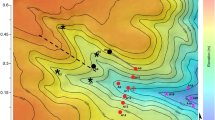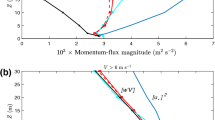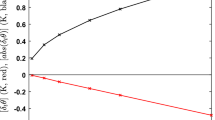Abstract
During the last week of June 1978, Melbourne experienced a prolonged period of stagnation over the city, resulting in high levels of air pollutants. Internal Froude numbers through the period ranged from approximately 0.1 to 0.3, indicating that flow in the area should be strongly stratified. Wind patterns determined using data from thirteen anemographs within and immediately adjacent to the city revealed a pattern of eddies across the city each afternoon in a ‘cavity’ in the lee of upstream topography. That pattern evolved with time, and changed between days as the controlling meteorological conditions altered. The available mean sea level pressure data from the region for the same times indicated perturbations in that field which were consistent with the observed wind patterns.
The eddy patterns were replaced at the surface overnight by katabatic winds as cooling took place and a ground-based inversion became reestablished. However, mean sea level pressure data and the anemograph records suggest that the eddy pattern may have continued overnight, aloft.
Considerable recycling of air occurred, both within individual circulations and by wind reversal between daytime and nocturnal regimes. This aided the persistence of high pollutant concentrations.
Similar content being viewed by others
References
Brann, H. N. and Templeton, J. I.: 1980, ‘Meteorological Factors Associated with High Pollution Episodes in Melbourne (June 1978)’, Clean Air 14, 43–45.
Brighton, P. W. M.: 1978, ‘Strongly Stratified Flow Past Three-dimensional Obstacles’, Quart. J. Roy. Meteorol. Soc. 104, 289–307.
Hunt, J. C. R. and Snyder, W. H.: 1980, ‘Experiments on Stably and Neutrally Stratified Flow over a Model Three-dimensional Hill’, J. Fluid Mech. 96, 671–704.
Manins, P. C: 1983, ‘Nocturnal Air Circulation in the Latrobe Valley’, Clean Air 17, 29–32.
Ryan, W. and Lamb, B.: 1984, ‘Determination of Dividing Streamline Heights and Froude Numbers for Predicting Plume Transport in Complex Terrain’, J. Air Poll. Control Assoc. 31, 152–155.
Spillane, K. T.: 1978, ‘Atmospheric Characteristics on High Oxidant Days in Melbourne’, Clean Air 12, 50–56.
Tapp, R. G.: 1985a, ‘The Occurrence and Duration of Weak, Near-surface Winds at Melbourne, Australia’, (submitted to Urban Ecology for publication.)
Tapp, R. G.: 1985b, ‘Patterns of Movement of Weak, Near-surface Winds at Melbourne, Australia’, Boundary-Layer Meteorol. (in press).
Wright, A. D. F.: 1974, Blocking Action in the Australian Region, Tech. Report 10, Bureau of Meteorology, Melbourne, Australia, 29 pp.
Author information
Authors and Affiliations
Rights and permissions
About this article
Cite this article
Tapp, R.G. Indications of topographically-induced eddies in stratified flow during a severe air pollution event. Boundary-Layer Meteorol 33, 283–302 (1985). https://doi.org/10.1007/BF00052060
Received:
Issue Date:
DOI: https://doi.org/10.1007/BF00052060




